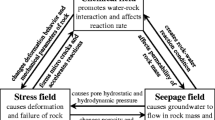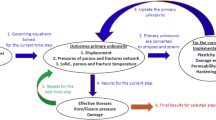Abstract
A general framework of hydro-mechanical-chemical coupling model is proposed for geomaterial subjected to the dual effects of mechanical loading and chemical degradation. Mechanical damage due to microcracks in solid matrix and chemical damage induced by the increase of porosity due to dissolution of matrix minerals as well as their interactions are considered. A special model is proposed for sandstone. The reaction rate is formulated within the framework of mineral reaction kinetics and can thus take into account different dissolution mechanisms of three main mineral compositions under different pH values. The increase of porosity is physically defined by the dissolution of mineral composition and the chemical damage is related to the increase of porosity. The mechanical behavior is characterized by unified plastic damage and viscoplastic damage modeling. The effective stress is used for describing the effect of pore pressure. The elastic parameters and plastic evolution as well as viscoplastic evolution are dependent on chemical damage. The advection, which is coupled with mechanical damage and chemical damage, is considered as the dominant mechanism of mass transfer. The application of model proposed is from decoupled experiments to fully coupled experiment. The model offers a convenient approach to describing the hydro-mechanical-chemical coupled behavior of geomaterial.
Similar content being viewed by others
References
Atkinson, B.K. and Meredith, P.G., Stress corrosion cracking of quartz: a note on the influence of chemical environment. Tectonophysics, 1981, 77: 1–11.
Freiman, S.W., Effects of chemical environments on slow crack growth in glasses and ceramics. Journal of Geophysical Research, 1984, 89(B6): 4072–4076.
Bulau, J.R., Tittmann, B.R. and Abdel-Gawad, M., The role of aqueous fluids in the internal friction of rock. Journal of Geophysical Research, 1984, 89(B6): 4207–4212.
Spiers, C.J. and Schutjens, P.M., Densification of crystalline aggregates by fluid-phase diffusional creep. In: Barber, D.J., Meredith, P.G. Editors, Deformation Process in Minerals, Ceramics and Rocks. London: Unwin-Hyman, 1990.
Lehner, F.K., Thermodynamics of rock deformation by pressure solution. In: Barber, D.J., Meredith, P.G., Editors, Deformation Process in Minerals, Ceramics and Rocks. London: Unwin-Hyman, 1990.
Seto, M., Nag, D.K., Vutukuri, V.S. and Katsuyama, K., Effect of chemical additives on the strength of sandstone. International Journal of Rock Mechanics and Mining Sciences, 1997, 34(3–4): 280.
Homand, S. and Shao, J.F., Mechanical behaviour of a porous chalk and water/chalk interaction, part I. Experimental study. Oil & Gas Science and Technology, 2000, 55(6): 591–598.
Li, N., Zhu, Y.M., Su, B. and Gunter, S., A chemical damage model of sandstone in acid solution. International Journal of Rock Mechanics and Mining Sciences, 2003, 40: 243–249.
Wang, S.J. and Wang, E.Z., Recent study of coupled processes in geotechnical and geoenvironmental fields in china. Elsevier Geo-Engineering Book Series, 2004, 2: 81–91.
Feng, X.T., Chen, S.L. and Zhou, H., Real-time computerized tomography (CT) experiments on sandstone damage evolution during triaxial compression with chemical corrosion. International Journal of Rock Mechanics and Mining Sciences, 2004, 41(2): 181–192.
Le Guen, Y., Renard, F., Hellmann, R., Collombet, M., Tisserand, D. and Brosse, E., Enhanced deformation of limestone and sandstone in the presence of a high pCO2 fluids. Journal of Geophysical Research, 2007, 112: B05421.
Feng, X.T. and Ding, W.X., Experimental study of limestone micro-fracturing under a coupled stress, fluid flow and changing chemical environment. Journal of Rock Mechanics and Mining Sciences, 2007, 44: 437–448.
Rimmelé, G., Barlet-Gouedard, V. and Renard, F., Evolution of the petrophysical and mineralogical properties of two reservoir rocks under thermodynamic conditions relevant for CO2 geological storage at 3 km depth. Oil & Gas Science and Technology, 2010, 65(4): 565–580.
Fernandez-Merodo, J.A., Castellanza, R., Mabssout, M., Pastor, M., Nova, R. and Parma, M., Coupling transport of chemical species and damage of bonded geomaterials. Computers and Geotechnics, 2007, 34: 200–215.
Feng, X.T., Ding, W.X. and Zhang, D.X., Multi-crack interaction in limestone subject to stress and flow of chemical solutions. International Journal of Rock Mechanics and Mining Sciences, 2009, 46(1): 159–171.
Xie, S.Y., Shao, J.F. and Xu, W.Y., Influences of chemical degradation on mechanical behaviour of a limestone. International Journal of Rock Mechanics and Mining Sciences, 2011, 48(5): 741–747.
Xie, S.Y. and Shao, J.F., Elastoplastic deformation of a porous rock and water interaction. International Journal of Plastics, 2006, 22: 2195–2225.
Lydzba, D., Pietruszczak, S. and Shao, J.F., Intergranular pressure solution in chalk: a multiscale approach. Computers and Geotechnics, 2007, 34: 291–305.
Pietruszczak, S., Lydzba, D. and Shao, J.F., Modeling of deformation response and chemo-mechanical coupling in chalk. International Journal for Numerical and Analytical Methods in Geomechanics, 2006, 30: 997–1018.
Carde, C., Escadeillas, G. and Francois, R., Use of ammonium nitrate solution to simulate and accelerate the leaching of cement pastes due to deionized water. Magazine of Concrete Research, 1997, 49: 295–301.
Taron, J., Elsworth, D. and Min, K.B., Numerical simulation of thermal-hydrologic-mechanical-chemical processes in deformable, fractured porous media. International Journal of Rock Mechanics and Mining Sciences, 2009, 46(5): 842–854.
Zhao, Z.H., Jing, L.R., Neretnieks, I. and Moreno, L., Analytical solution of coupled stress-flow-transport processes in a single rock fracture. Computers & Geosciences, 2011, 37(9): 1437–1449.
Choi, S.K., Ta, C.P. and Freij-Ayou, R., A Coupled mechanical-thermal-physico-chemical model for the study of time-dependent wellbore stability in shales. Elsevier Geo-Engineering Book Series, 2004, 2: 581–586.
Kang, Q.J., Zhang, D.X. and Chen, S.Y., Simulation of dissolution and precipitation in porous media. Journal of Geophysical Research, 2003, 108: 2505.
Ding, W. and Feng, X.T., CT experimental research of fractured rock failure process under chemical corrosion and permeation. Chinese Journal of Rock Mechanics and Engineering, 2008, 27(9): 1865–1873.
Qiao, L.P., Liu, J. and Feng, X.T., Study on damage mechanism of sandstone under hydro-physico-chemical effects. Chinese Journal of Rock Mechanics and Engineering, 2007, 26(10): 2117–2124.
Cui, Q., Feng, X.T., Xue, Q., Zhou, H. and Zhang, Z.H., Mechanism study of porosity structure change of sandstone under chemical corrosion. Chinese Journal of Rock Mechanics and Engineering, 2008, 27(06): 1209–1209.
Hu, D.W., Zhou, H., Zhang, F. and Shao, J.F., Evolution of poroelastic properties and permeability in damaged sandstone. International Journal of Rock Mechanics and Mining Sciences, 2010, 47(6): 962–973.
Pietruszczak, S., Jiang, J. and Mirza, F.A., An elastoplastic constitutive model for concrete. International Journal of Solids and Structures, 1988, 24(7): 705–722.
Zhou, H., Hu, D.W., Zhang, F. and Shao, J.F., A thermo-plastic/viscoplastic damage model for geomaterials. Acta Mechanica Solida Sinica, 2011, 24(3): 195–208.
Zhou, H., Jia, Y. and Shao, J.F., A unified elastic-plastic and viscoplastic damage model for quasi-brittle rocks. International Journal of Rock and Mining Sciences, 2008, 45: 1237–1251.
Hu, D.W., Zhu, Q.Z., Zhou, H. and Shao, J.F., A discrete approach for anisotropic plasticity and damage in semi-brittle rocks. Computers and Geotechnics, 2010, 37(5): 658–666.
Lasaga, A.C., Kinetic Theory in Earth Sciences. Princeton: Princeton University Press, 1998.
Mura, T., Micromechanics of Defects in Solids. Martinus Nijhoff Publishers, 1987.
Hori, M. and Nemat-Nasser, S., Double-inclusion model and overall moduli of multi-phase composites. Mechanics of Materials, 1993, 14: 189–206.
Shao, J.F., Poroelastic behaviour of brittle rock materials with anisotropic damage. Mechanics of Materials, 1997, 30: 41–53.
Wolery, T.J., EQ3/6: Software package for geochemical modeling of aqueous systems: Package overview and installation guide (version 8.0), Lawrence Livermore National Laboratory Report UCRL-MA-110662 PT I, Livermore, California, 1992.
Author information
Authors and Affiliations
Corresponding author
Additional information
Project supported by the National Natural Science Foundation of China (Nos. 51009132, 50920105908, 50979104 and 10972221) and the Open Research Fund of State Key Laboratory of Geomechanics and Geotechnical Engineering, Institute of Rock and Soil Mechanics, Chinese Academy of Sciences (No. Z011006).
Rights and permissions
About this article
Cite this article
Hu, D., Zhou, H., Hu, Q. et al. A Hydro-Mechanical-Chemical Coupling Model for Geomaterial with Both Mechanical and Chemical Damages Considered. Acta Mech. Solida Sin. 25, 361–376 (2012). https://doi.org/10.1016/S0894-9166(12)60033-0
Received:
Revised:
Published:
Issue Date:
DOI: https://doi.org/10.1016/S0894-9166(12)60033-0




